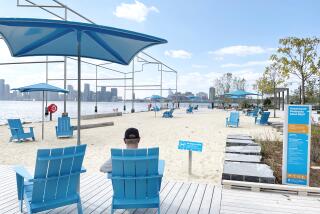Developers Eyeing Slice of Big Apple : Property: Coast Guard’s withdrawal from historic Governors Island inspires plans for public park, or a community for the rich.
- Share via
NEW YORK — The first time it changed hands, Governors Island sold for two ax heads, a string of beads and a handful of nails. The next time around it could go for $500 million--or $1.
The Coast Guard plans to leave the New York harbor island by the end of 1998, closing its largest base and saving $30 million a year. If Congress approves, the city and state would get first crack at acquiring the property just 800 yards off Manhattan’s southern tip.
If they can’t reach a deal, developers are eager to bid for the 175 acres with sweeping views of Lower Manhattan’s eye-popping skyline, the Statue of Liberty and Ellis Island.
“The real estate people I’ve talked to say it is one of the most amazing, tantalizing urban development opportunities anywhere in the world,” said John Dyson, deputy mayor for economic development.
Developer Donald Trump says the island is “great visually, great artistically and great for security”--conjuring visions of a moated, high-rise community for the mega-rich.
Park advocates, however, see great potential for public use, perhaps modeled on the annexation of San Francisco’s Presidio, another longtime military installation, to the Golden Gate National Recreation Area.
Congress estimates that the island is worth at least $500 million. But Dyson notes hopefully that California got the federal government to part with Ft. Ord, and its six miles of prime oceanfront near Monterey, for a token $1.
Since 1966, the Coast Guard has used Governors Island for training and operations ranging from search and rescue to drug interdiction. Home to about 4,000 people, it has a distinctly small-town atmosphere. Amenities including a post exchange, motel, Burger King, public school, bowling alley, movie theater, tennis courts, nine-hole golf course and swimming pools.
On a recent weekday visit, parked bicycles could be seen unlocked. Golfers played the course laid out between the Victorian brick mansions known as Colonels Row and Noland Park, a grassy quadrangle surrounded by restored yellow clapboard homes for senior officers.
From the ferry landing, where a whistle announced departures every 15 minutes around the clock, to Yankee Pier, where a deckhand chipped paint on an icebreaker, an unhurried pace prevailed.
Lt. Cmdr. Paul Milligan, who has lived on the island with his family for more than seven years, said it combines small-town life with access to the “hustle and bustle and excitement . . . [of the] most glorious city in the world.”
“You get the best of both cultures,” Milligan said, “and it’s simply a seven-minute trip away.”
The island’s history goes back to 1637, when Dutch governor Wouter van Twiller bought an expanse called Pagganck from two Canarsee Indians named Cakapeteyno and Pehiwas for the beads, nails and axes.
The Dutch named it Nutten Island for its groves of chestnut, oak and hickory trees, and set up a wind-powered sawmill to provide planks for the growing settlement of New Amsterdam. After the British took over, they renamed the settlement New York and reserved the island “for the benefit and accommodation of His Majestie’s Governors.”
On the eve of the American Revolution, Benjamin Franklin surveyed the island’s potential as a fortress and advised, “Six guns would be sufficient . . . and 12 pdrs [pounders] would be heavy enough.”
A force of 1,000 men worked through the night of April 8, 1776, to install the guns and other defenses. George Washington pronounced the island “more strong and better guarded than any other port in the Army.”
It was soon tested. The British massed their fleet in the lower harbor, but the guns on Governors Island kept them from moving up the bay. Gen. William Howe attacked Washington’s forces on Long Island and drove them back to Brooklyn Heights.
The revolutionary army could have been destroyed, but the battery on Governors Island provided cover for Washington and his men to retreat by night.
Back in American hands after the war, the island was leased for use as a racetrack and later served as a quarantine station.
Castle Williams, a circular red sandstone bastion nicknamed “The Cheesebox,” was completed in 1811 with walls eight feet thick. It featured 100 cannons and an outer wall made of dovetailed stones so no one block could be removed without first being broken into pieces.
But its cannons were never fired in battle. Some historians believe that the British attacked and sacked Washington instead of New York City during the War of 1812 because they were daunted by Governors Island’s defenses.
After the Civil War, during which Castle Williams was a prison for Confederate soldiers, the Army made the island an administrative center and headquarters and built the mansions of Colonels Row.
The dawn of aviation brought Wilbur Wright to demonstrate his plane, “Flyer.” He took off from the island Sept. 20, 1909, for a spin around the Statue of Liberty.
In 1988, the island was the site of Ronald Reagan’s last meeting as President with then-Soviet leader Mikhail S. Gorbachev.
More to Read
Inside the business of entertainment
The Wide Shot brings you news, analysis and insights on everything from streaming wars to production — and what it all means for the future.
You may occasionally receive promotional content from the Los Angeles Times.







